The most pleasing chore I have had in the yard over the past few weeks has been making sure that branches don’t break under the weight of their fruit. This certainly hasn’t been needed on all of my fruit trees, but there are some this year that would be torn apart if I didn’t intervene and thin the crop. What a chore that isn’t a chore!
And making sure that trees aren’t damaged is the only reason that I ever remove fruit.
Thin fruit to increase size?
I know that some people thin fruit with a different goal in mind — specifically, to attain bigger fruit.
This has long been the tradition. “The one chance for the home gardener to get bigger and better fruit than he can buy is in the thinning process,” reads the original 1954 edition of the Sunset Western Garden Book.
How is this said to work? “A tree’s leaves supply energy for growth; if there are not enough leaves on the tree to support the number of fruit that set, the fruit will, in effect, compete with each other for carbohydrates and so remain small,” explains Chuck Ingels in The Home Orchard.
And so you can even find ratios for how many leaves a tree needs in order to grow a single fruit to its maximum size. “On average, twenty-five to forty leaves produce the green nutrition to support a growing fruit,” writes Michael Phillips in The Holistic Orchard.
Methods of thinning fruit
From here, we are offered different methods for thinning a tree’s crop in an efficient and effective manner. We can count leaves, but this is time consuming. We can take an estimate of the tree size and then estimate how many pieces of fruit that tree can develop to full size. For example, in the book Peaches, Plums, and Nectarines: “In California, early season peaches and nectarines are thinned to anywhere from 300 to 900 fruit per mature tree, depending [on various factors].”
But the thinning method that is easiest to follow is based on fruit spacing. Ingels in The Home Orchard: space peaches and nectarines 5 to 7 inches apart on a branch; space plums 4 to 6 inches apart; and space apricots 3 to 5 inches apart.
Kevin Hauser, in his book Growing Apples in the City, suggests removing all but one apple per cluster (there’s usually five) and spacing each fruit at least 8 inches apart. Similar spacings are usually recommended for pears.
(The practice of thinning fruit is most common on peaches, nectarines, and apples; and then it’s also often advised for plums, apricots, and pears too.)
The theoretical explanation to support the idea that thinning fruit will “allow each remaining fruit to develop to its maximum size” (The Home Orchard) makes perfect sense to me, but does it work in practice? What I’ve observed in my own trees and the trees of others leaves me unsure.
Fewer fruit means bigger fruit?
I’ve been thinking a lot about the practice of thinning fruit over the past month, and I’ve jotted down dozens of examples of trees that do and don’t have bigger fruit when they have fewer fruit. I won’t list them all here. I’ll mention a few that incorporate trees of different kinds, and I’ll suggest possible explanations for what they show.
I’ll start with the example of my Royal Blenheim apricot tree because I actually wrote a post about thinning its fruit a few years ago: “Don’t thin apricot fruit in order to increase fruit size.” As the title makes obvious, I found no difference in fruit size between a year when I thinned the fruit a lot and a year when I didn’t.
One possible explanation for this is that I keep this tree pruned small (to the height of my reach).
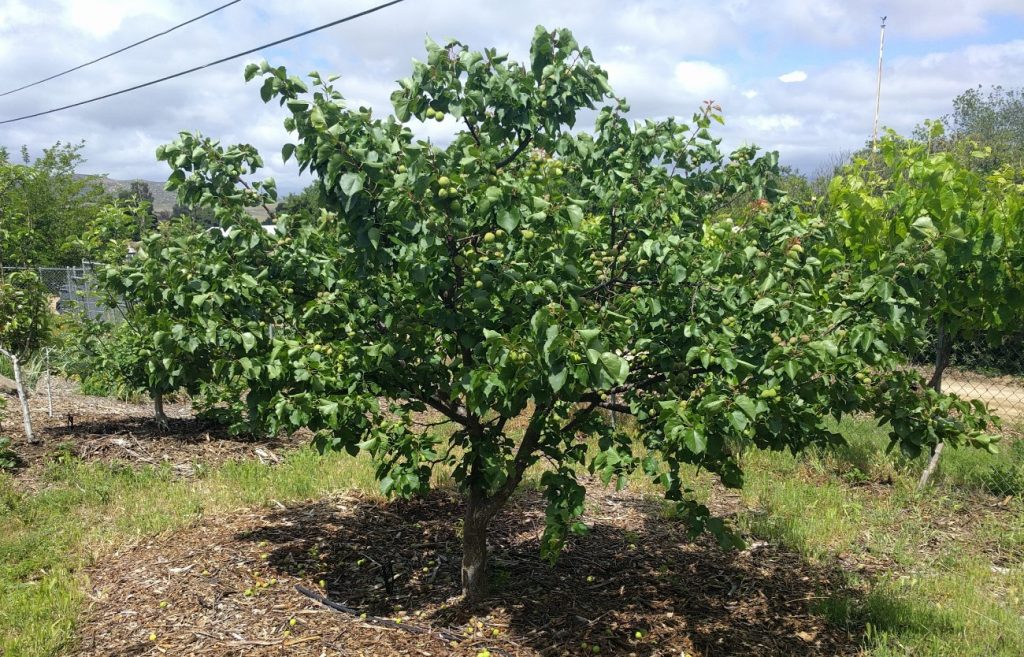
Why would this matter? Pruning can be considered a form of fruit thinning; it’s just that the fruit was “thinned” before it was ever allowed to appear in the first place.
However, when you prune a tree you cut off branches that would also have leaves, and those leaves would be photosynthesizing and able to support the growth of fruit. So I’m unconvinced that this explanation captures what is going on with my apricot, at least not in full.
Variety largely determines fruit size?
Variety might determine the size of fruit more than crop load. Examples of this abound. My grandmother had a peach tree whose fruit she didn’t thin, and we found it with a main branch snapped under the weight of multitudes of large peaches. I have a peach tree whose fruit is always tiny no matter how many pieces of fruit I allow it to keep. It seems that these trees are destined to produce a certain size of fruit regardless of how much fruit they carry.
And I’ll add one more example just because it is extreme even though it does not involve the typical deciduous fruit trees that are usually thinned. I have a Reed avocado tree that is about 12 feet tall, and because of last July’s heatwave, it dropped all of its fruit except one. That’s some extreme thinning.
How big is that single avocado fruit being powered by hundreds of leaves? Just normal size for the Reed variety.
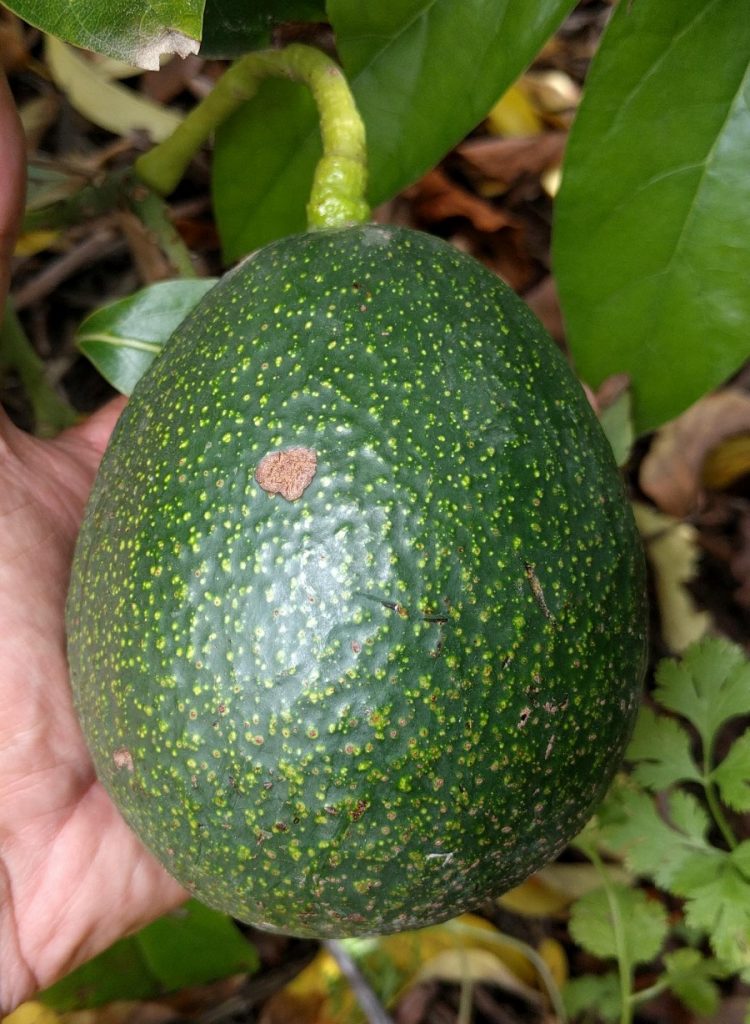
Climate influences fruit size
When a particular fruit tree grows in a climate it finds suitable, it seems to produce bigger fruit no matter how much fruit it has in a given year. I often visit friends and family in the Pacific Northwest, and when I do I take note of domesticated and feral fruit trees alike. The apple trees up there are always mobbed with fruit — way more crowded than spacing guidelines recommend — and yet the fruit is often large.

The apples on my trees in Southern California, on the other hand, are often on the small side — even though I keep the crop loads down in comparison to the trees up north. Other apple trees I know in Southern California likewise usually have fruit on the small side. (One exception is my grandmother’s Beverly Hills variety apple tree.)
My sense is that climate is the main factor influencing fruit size here. Apples love to grow, and grow big, in Oregon and Washington in comparison to Southern California.
So do pears. Here is a Bosc pear tree I found growing on the grounds of Rogue Farms in Independence, Oregon that is breaking all the thinning rules and yet has fruit as big as any Bosc pears I’ve ever seen.

Other factors influencing fruit size
There are many factors that influence the size of the fruit on a tree, some of them certainly still unknown to me. All of the authors and resources that I quoted above do make mention of factors other than thinning that influence fruit size. In fact, Peaches, Plums, and Nectarines adds that lack of required winter chill can cause smaller fruit, as can extreme summer heat.
Yet, the practice of thinning a tree’s fruit quantity is treated in most of these resources as having the potential to significantly alter the size of individual fruit remaining on a tree, and I just don’t see it. Of the trees I know, the correlation between low fruit quantity and large fruit size is inconsistent at best.
My reason for thinning fruit
Therefore, if I remove fruit from my trees I do so with a different aim: to maintain the health of the tree.
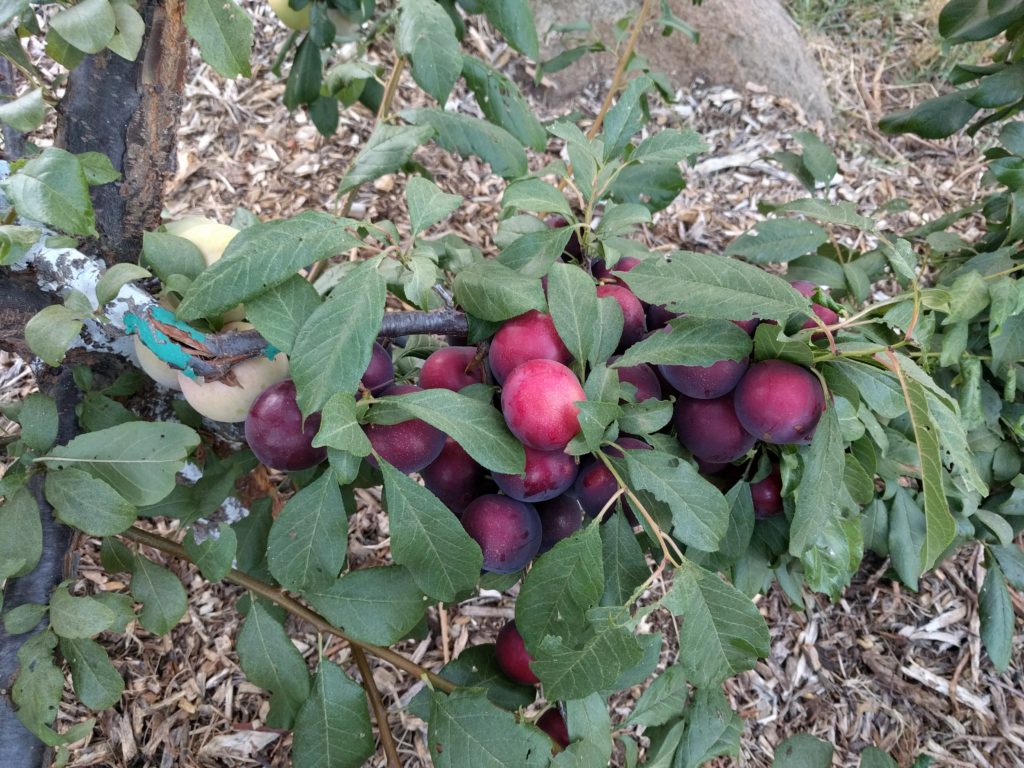
I’ve broken branches because I didn’t thin enough, and I’ve sunburned branches and fruit for the same reason. (See my post “Oh, the mistakes I’ve made: Not thinning enough fruit on a plum tree.”) I’m determined not to do that again.
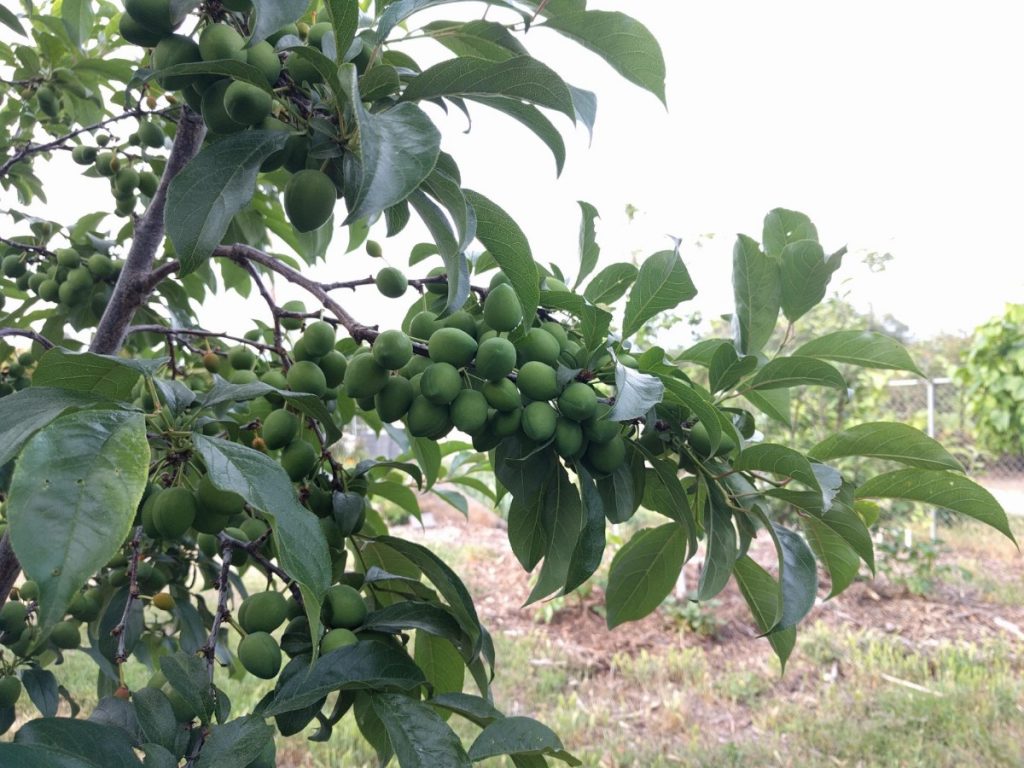
How I thin fruit
Here is, briefly, how I go about thinning fruit in order to ensure that trees aren’t damaged. I look for branches that are hanging down from the weight of fruit and appear to have the potential to either break or be exposed to sunburn. Branches whose bark is not shaded by leaves and which are horizontal or facing south or west are especially prone to sunburn. I remove as much fruit as necessary on those branches.
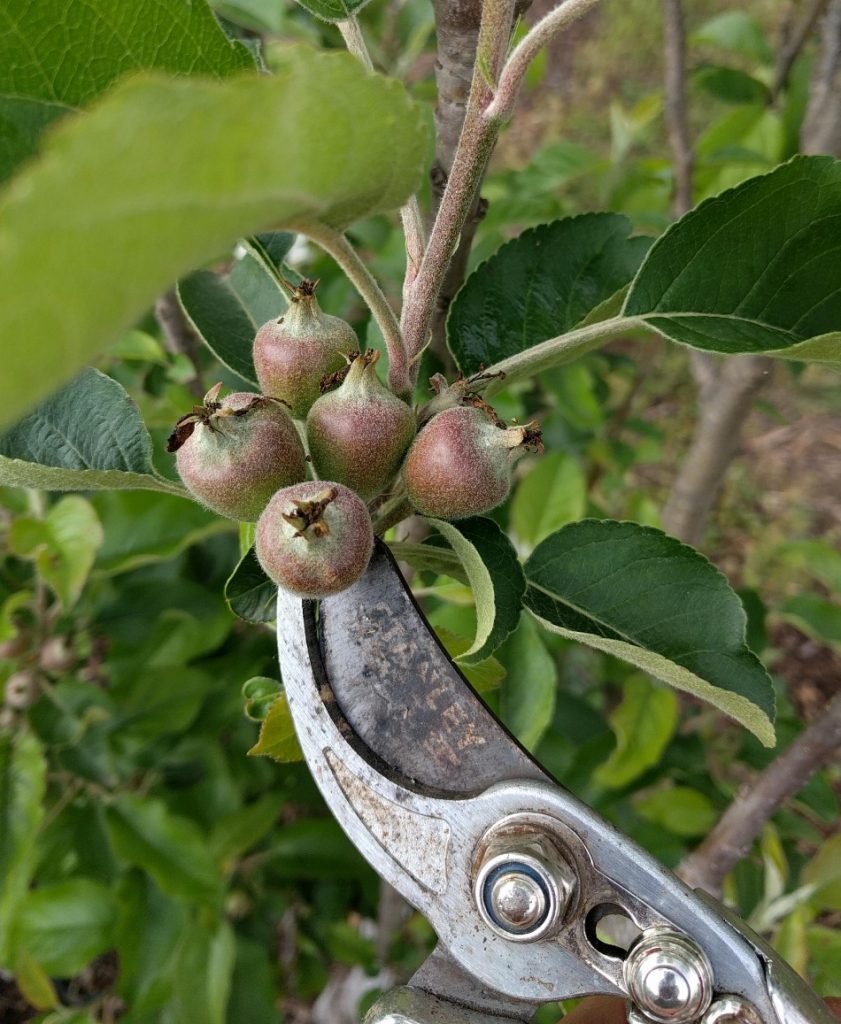
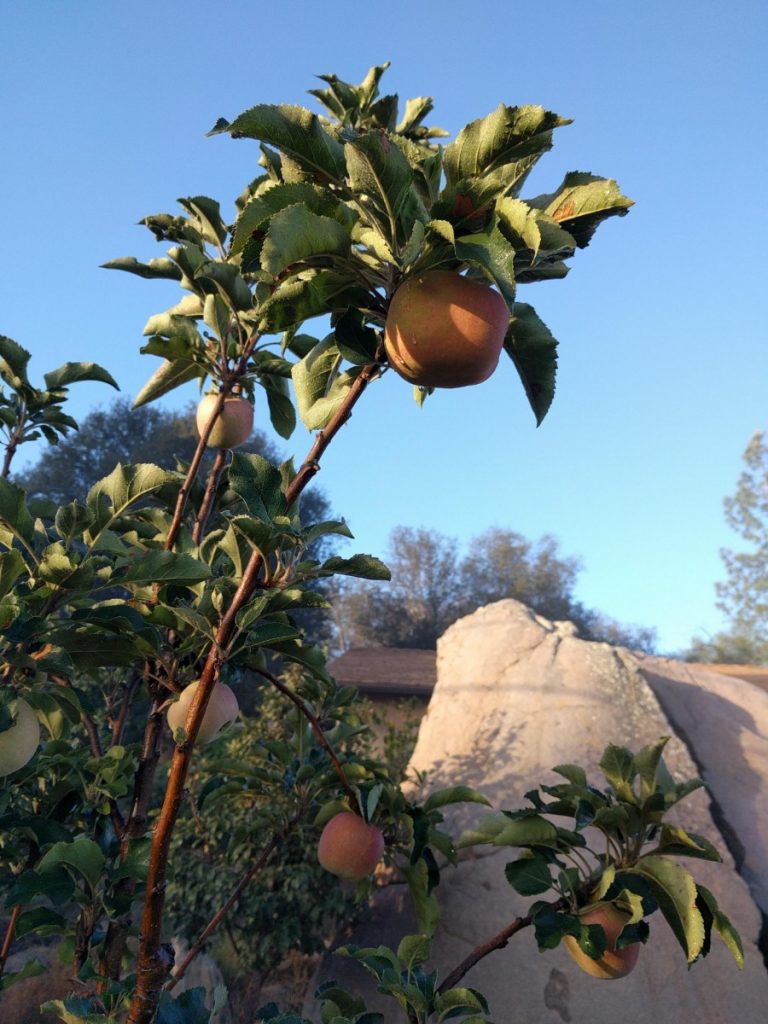
This goes for the deciduous fruit trees that we typically thin, but it also goes for evergreens like citrus, mango, and avocado (especially certain varieties, such as the notorious branch-breaker Reed.)
Which fruit to thin
I first look to remove fruit that is imperfect, if possible: scarred, very small, deformed, doubled, spurred. I also look to remove fruit near the tip of a branch more than at its base because fruit at the tip has more leverage and causes more hanging.
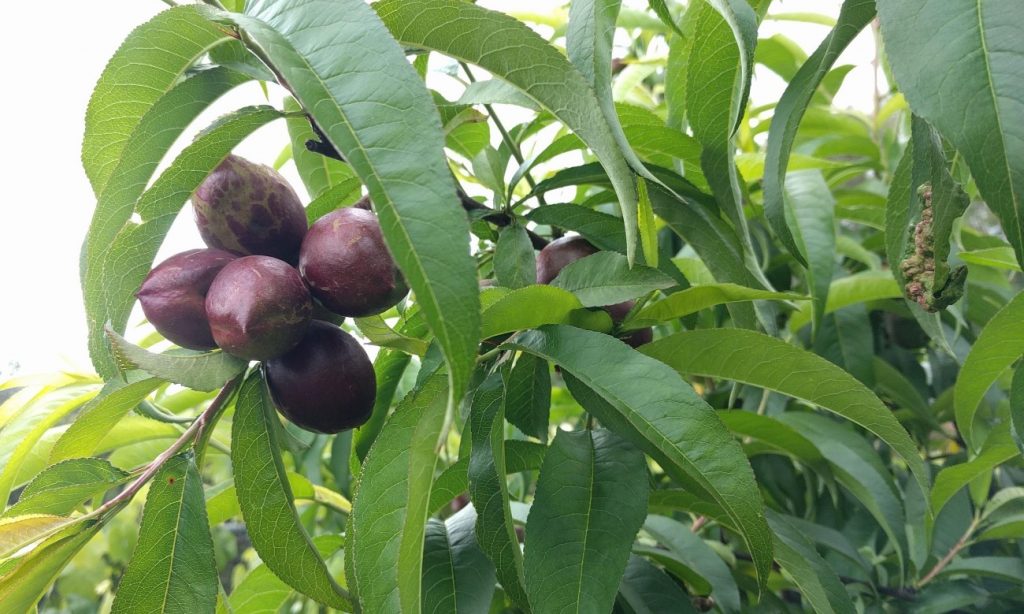
Thin in rounds
But I am not a courageous fruit thinner so I never get the job done in one episode. I thin fruit in rounds.
The first round happens whenever the fruit is at a size where little to no fruit will continue to drop naturally. If you try to thin fruit when it’s only pea size, then you’re thinning some fruit that the tree wasn’t going to keep anyway. Wait a few more weeks and you’ll see that some fruitlets turn yellow or shrivel or stop growing or just seem to disappear; they were not completely pollinated or something else caused the abcission.
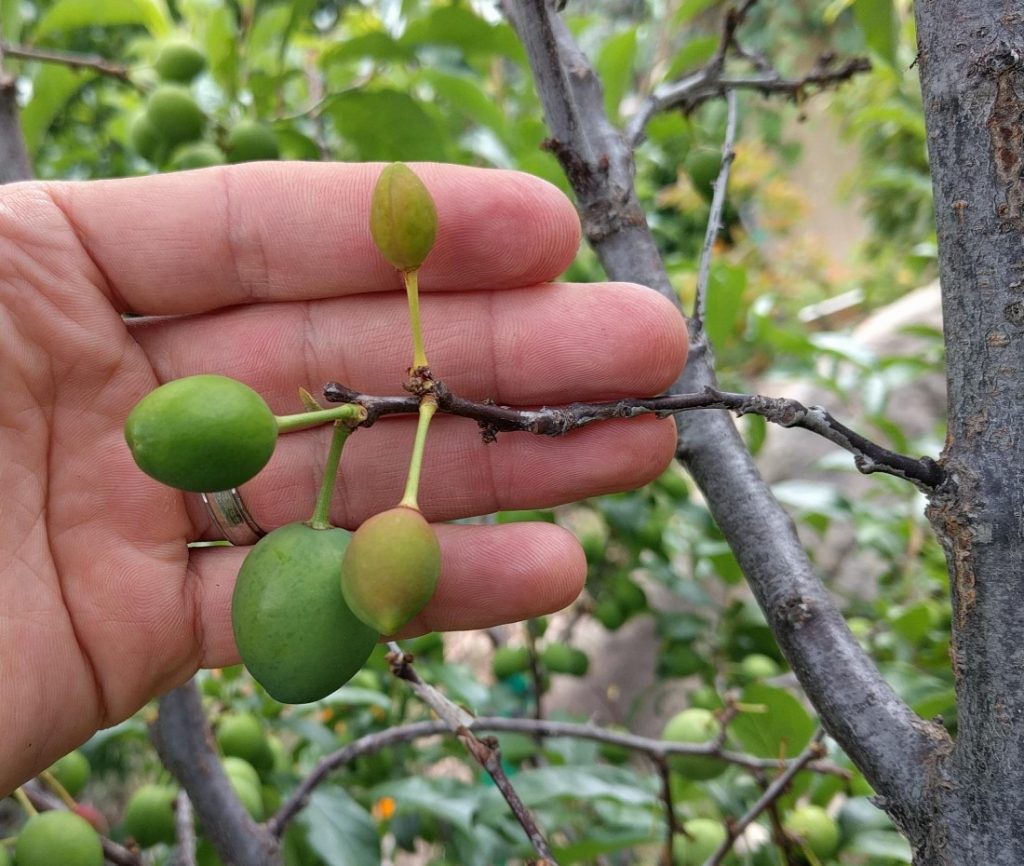
When peaches, nectarines, plums, apricots, pluots, apples, and pears are between marble and golfball size, and they look healthy, then they are probably set for life. If you want to remove some of them, then at that size you can be sure you’re dealing with the tree’s real crop load.
I always later end up noticing branches that remain too heavy and have to do second or third passes through a tree to thin a little more.
The upshot of my couple rounds of thinning fruit for the health of the tree is that, ironically, I end up leaving only a bit more fruit on my trees than traditionally recommended. So in a sense, the main practical difference between my approach and thinning with the aim of attaining large fruit is what’s in the mind of the thinner. The total number of fruit remaining on the tree is not always significantly different.
I’m not alone!
Nevertheless, I was glad that I confessed my suspicions about the effect of thinning on fruit size to a group of fruit-tree enthusiasts last week. At a meeting of the North San Diego County chapter of the California Rare Fruit Growers, I asked if anyone else had not noticed fruit growing bigger on trees with thinned crops, and some said they had.
That made me feel less crazy. And to boot, someone at the meeting mentioned that she actually preferred small fruit anyway.
I do too! I said.
We agreed that we didn’t understand the appeal of an apple that is so big that you have to refrigerate half of it for later. But what does that have to do with thinning?
You might also like to read my post:

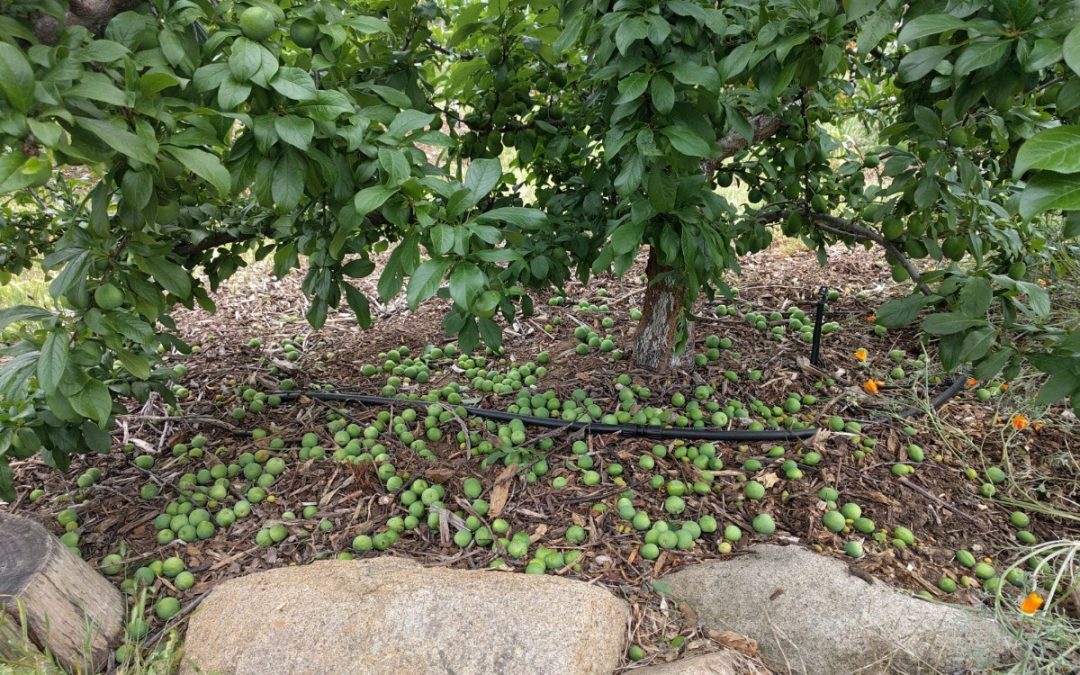


I bought a home last year with a mature peach tree. The fruit are so small – smaller than a golf ball. Though the tree is heavily laden with fruit. I have pruned branches heavy with fruit.
So next year , according to your article, I can again expect small fruit.
Hmm. I love the flowers in the spring. But such small, insignificant fruit. Bummer.
Hi Leslie,
Any chance your peach tree has more than one trunk? If so, it’s likely that your peaches are small because it’s rootstock that has taken over, and the rootstock variety bears small fruit.
I just found you and so happy I did. I really enjoyed your article about thinning but I know this will be hard because I get so excited when I find new baby lemons ?. My question is on another problem, I got my lemon tree last year and it had about 12 lemons which I thought was wonderful. But Greg my tree is blooming like crazy and has green fruit but not many leaves. What can I do to rectify this. Thanks for your help, Nelda
Hi Nelda,
That isn’t a good sign. I would remove fruit on such an unhealthy tree. You want it to use whatever energy it has to recover instead of producing fruit right now.
You also need to figure out why it’s struggling. Often, it’s a watering issue. And often, it’s too much water rather than not enough. But I have no idea what is going on with your tree specifically; just pointing out that you should consider the watering first.
I thinned all of my trees in several rounds as well. Even after heavy thinning I was still overwhelmed by a lot of fruit. I had a few left over 6 foot fence boards laying around so cut notches every 6 inches or so to about 4 1/2 feet and use them to prop the heavy branches (along with wide green tape). These boards are moving from tree to tree as I pick one enough to not need the help. This has been an amazing year for fruit so far. We had nectarine cobbler last night.
Hi Bob,
It’s like you’re running a commercial orchard there!
I do agree, one simple rule is not true for fruit in every location.. I have a pomegranate tree where 3 to 4 fruits are crowded together. Soon I am planning to remove at least 2 among the 4.Because last year they were thin and I had big fruits. This year I am worried that the fruit size may be small. Please advise if you have any.
Thaks
Hi Benu,
You might want to try the opposite this year: don’t thin and see if they’re still as big as last year.
I have a couple pomegranates that I’ve never thinned, and the fruit is never as big as I’ve seen some other pomegranates get but that may be due to difference in variety or irrigation. I don’t water my pomegranates.
I do know other pomegranate trees that aren’t thinned and still have very big fruit.
The place I just newly moved to had a persimmon that only held 6 fruit this past year, this year it is loaded with blossoms. At first I was patting myself on the back because I thought it was due to my ministrations that the tree was finally responding but then I read up on alternate bearing cycles where a Fuyu persimmon may have a ton of fruit one year and hardly any the next. So I’ve been thinning the fruit which is one way to break the cycle. I’ve probably taken off at least 100 flowers and the tree is actually dropping some on it’s own as well.
PS It’s around 94F today… forecast called for high 80’s. Weather report never get things right. Time to go pickup shadecloth and set it up for my poor almost naked Hass.
Hello Greg
My Necta Zee miniature nectarines are starting to ripen. After I pick off all the fruit do you recommended hi nitrogen fertilizer? I would like to to get some growth so I can have longer and more fruiting branches.
Hi Sergio,
I haven’t grown any of the miniature peaches or nectarines, but I’ve seen them. And because they are naturally small trees with short internodes (spaces between leaves on a branch), I don’t think you’ll get the results you’re after by fertilizing your Necta Zee. Essentially, you have a runt of a nectarine tree — which is great for certain situations — and no amount of fertilizing will change this nature.
That being said, if the soil it is growing in is infertile now, then there’s no harm in increasing the fertility so that the tree grows as vigorously as possible.
But again, I’ve never grown this tree so I can’t say firsthand how it will respond to a high nitrogen fertilizer.
Hi Greg!
I recently came across your blog and I am loving it!! Thanks for posting so much wonderful information about gardening in Southern California!!
What is your rule of thumb for thinning apples? Do you ever prop up branches of a young fruit tree to keep the fruit or do you just thin the fruit? I just bought my apple tree this last Spring.
I’ve also heard mixed thoughts on whether or not you should fertilize during flowering or fruiting. What are your thoughts?
Hi Emily,
Thanks! I thin apples a little more than I thin some other trees, such as apricots, because apples can get big and heavy and weigh down the flexible apple branches, which exposes the branches and fruit to sunburn.
I judge how much to thin each apple tree or branch according to how much fruit is on the whole tree as well as how much is on a single branch and how the fruit is affecting that branch. For example, my Fuji apple tree doesn’t have a ton of fruit on it as a whole this year. So I haven’t thinned it very much, but I have thinned certain branches that are small and can’t properly carry the weight of so much mature fruit.
As another example, my Pink Lady has many stouter, more vertical branches, and I find that I can thin it less because such branches hold fruit better than thin and horizontal branches.
In climates where the sun isn’t so intense you don’t need to worry about this, but in my yard apples and apple branches get sunburned in a heartbeat.
I’ve never propped up a branch on an apple tree, but just the other day I propped a branch on an avocado tree rather than thinning the fruit. Sometimes I just really don’t want to sacrifice the fruit to thinning so I prop. But that avocado tree is older. For a young tree, it’s usually wiser to remove any fruit that it can’t handle so it grows well for future years. (This doesn’t necessarily mean removing all fruit.) I’ve had it come back to bite me when I got greedy and tried to let a young tree carry too much fruit.
I avoid the whole issue of when and how much to fertilize by only using compost and wood-chip mulch. They work great on both vegetables and fruit trees; you don’t need to add anything additional except in rare circumstances (e.g. acidifying soil under blueberries); and you can add them any day of the year.
Hi Greg, enjoy your gardening articles. I would like to know how much should I water my peach tree. It is a few years old and I never had much in the way of peaches and thought of cutting it down but this year it is full of fruit. There are some that are small and in groups of two or three or four. They are smaller than a golf ball, hard and pinkish and yellow. So should I water once a week or more and should I thin some of thes Siamese twin peaches? Any help would be appreciated. I am in Canoga Park where it is quite hot now! Thank you
Hi Mary,
It sure has been hot here in San Diego County too. I would thin all of the Siamese twin peaches (or “doubles”) as long as you have lots of other peaches that aren’t malformed.
Here is a post that I wrote about this time last year in order to help us know about how much water to give our fruit trees: https://gregalder.com/yardposts/how-much-to-water-a-fruit-tree-in-southern-california-roughly/
Thank you, Greg. There are a lot of these Siamese twins and will take them off as there are a lot on the tree.
Thanks again for the very useful information, too, about watering…will do.
Hi Greg,
Well written and timely. An oddity of fruit thinning that has befuddled me is many people are surprised by the idea. I’ve helped thin fruit at a home, only to get the feedback the spouse thought it was “stealing”. My wife today asked me if we were going to get any navel oranges, as I’d had just thinned this 2 year old tree (answer: yes, they’re down low and close to center of tree). See ya, Robert
Hey Greg,
Not sure if you’re still reading and responding to comments on this post, but I thought I’d give it a shot.
My question is related to the subject of this, but a little distantly, so it’ll take a bit of a story. When we moved into our house a little over a year ago (August 2019), there was a small Fuji apple tree in the yard. The previous tenants hadn’t been gardeners, and didn’t do too much watering, so it was limping along and only had two apples on it. When we moved in we started watering regularly, and it started producing a profusion or flowers – in September! It never lost its leaves through the winter, and went on to ripen a pretty full crop of apples in about June or July.
It also has put on absolutely no vegetative growth since we moved in (13 months now), and is just beginning to bloom again, and I am getting a bit concerned.
I would like the tree to put on vegetative growth and not remain in its stunted state, and I wonder if that is tied to the odd timing of fruiting. Do I pull all the leaves off in winter and induce dormancy myself? So I give up and plant another tree? Something else entirely?
Any insight would be welcome.
Hi Joe,
Great story; I can relate! We moved into our place in July 2013. There were some old apple trees here that hadn’t been watered for months and hadn’t been watered well for a few years. I started watering them and . . . bloom!
It’s a common thing for some fruit trees to bloom no matter the time of year after they go through a period of drought or heat stress and then get relief through irrigation or mild weather. I’ve seen it with citrus and pears, too.
What to do with your Fuji? I would try to force it back into a normal cycle. I would remove any bloom it puts out now.
All apples drop leaves late in winter, if at all, in Southern California. My Fuji doesn’t drop all of its leaves almost until winter is over. I’ve never stripped the leaves; I’ve let it follow its delayed schedule. But for yours, I’d be tempted to try stripping it around January if it hadn’t dropped many of its leaves already on its own. I know of people who routinely strip the leaves on their apple trees in winter like this and the trees perform well. Maybe this will help it adjust its schedule.
Thanks for the reply Greg, it gives me more hope than I had!
I’ll do as you say and pull the blooms off now, and the leaves in January if it hasn’t lost them on its own. Fingers crossed!
I’m sure it’s confusing to be a deciduous tree here, especially where I am (Los Osos), so close to the coast. Summer often has lower high temperatures than winter!
Fuji apples blossom in clusters of five. If left they don’t make very good or even edible fruit. I prune to two fruit max, sometimes to one at a branch tip, as shown in your video. I’ve noticed that if I nip the blossoms as soon as they show signs of being pollinated, the tree seems to put out blooms elsewhere. Were they going to bloom there anyway? I have no proof. At least early pruning doesn’t allow the tree to squander energy on growing fruitlets I would prune anyway.
Hi Greg,
Veeeery interesting! I just got done thinning all my stone fruit and apples.
My question is of a different nature: What do you do about Peach Leaf Curl (PLC) on stone fruit? Here is North Pasadena, it’s a bit of a plague. As per Home Orchard and IPM, I finally started spraying, which broke my organic gardener’s heart, but it helped. This past year because of all the rain, I never got around to it. And, it’s baaaaaack.
All my 6 stone fruit are affected to varying degrees. Have you ever had this problem?
Thanks so much for any and all advice!
Hi Cara,
I have a funny answer to this one: https://gregalder.com/yardposts/wheres-the-peach-leaf-curl-in-2021/
And: https://gregalder.com/yardposts/spring-happenings-2023/
And, again, how veeeeery interesting! Thanks so much, Greg. Great posts. I always wondered it the weather/rain had anything to do with it….
Thank you for all you do!
I believe the confusion related to fruit thinning is due to having many variables. If a fruit tree is planted in rich soil with proper drainage where the soil is 10 ft in a radius from the trunk with full sun and an inch of rain once a week, it will have the basics to produce the maximum size fruit for its variety and it will be able to support a ton of fruit. Most fruit trees need pruning and shaping for maximum air flow and sunlight as well as structure (short branches to support the fruit load). When soil, sun, water, air flow, etc are limited in some way, fruit size will suffer therefore, thinning fruit will increase size. My statement is based upon my personal experience.
All my fruit trees had masses of blooms this year which BTW was a little warmer than usual. My surprise is a slender Reed avocado I planted in ground early April, soon showed 6 or 7 BB’s before pollinators were around. I thought Reeds were supposed to be late bloomers. The leader has a good flush of leaves and the few odd branches have smaller but healthy flushes. I got it from Epicenter in the Watsonville area which i don’t think is all that much warmer in March or very early April. Have you found Reeds to self pollinate much?
Hi Larry,
It’s great that your trees are blooming a lot this year. Down here we’ve had a foggy spring until this week.
I visited two nearby farms with Reeds that were in full bloom in April whereas my Reeds did not reach full bloom until late May, and my oldest Reed still has many flowers opening here in mid June.
I would say that Reed usually peaks in bloom and has flowers open later than most other varieties, from what I’ve seen. But young trees often don’t display the behavior that older trees do, and trees recently from a nursery don’t either, not to mention that rootstocks have some influence over flowering.
I agree that the Epicenter location is probably not much warmer than yours, but the tree might have spent the winter in the greenhouse and that would have made for a warmer few months before you picked it up.
It will be interesting to see how it blooms in the next few years.
Regarding self pollination: Oh yeah! Reed does it! My Reed can still have open flowers in early July, long after other avocado trees have finished flowering, and the flowers set fruit. I’ve also seen a number of lone Reed trees elsewhere that set fruit well.